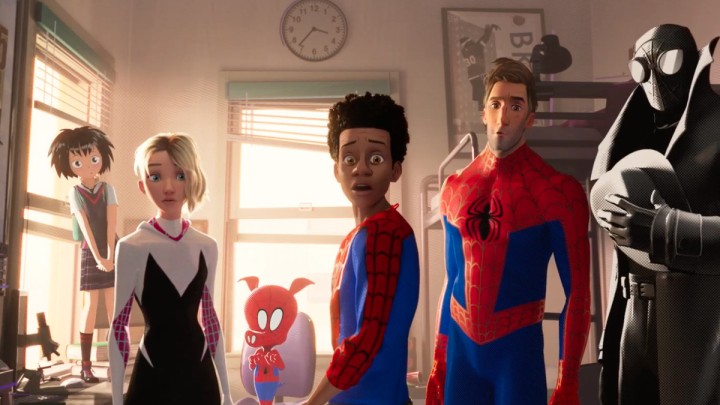Sony’s Spider-Man: Into the Spider-Verse is the second Spiderverse film this year after Venom and the second film to feature a web crawler after Avengers Infinity War. That’s on top of a critically acclaimed game that released on the PS4 this fall. So we’ve had plenty of web-slinging action this year. But if you’re feeling a bit of superhero fatigue by the end of 2018 and feel you may want to skip Spider-Verse and wait for Netflix, don’t. Sony’s Into the Spider-Verse is one of the year’s best films and one of the best superhero films ever.
Any fan of Marvel comic books will know that there are multiple continuities which allows for the writers to tell new stories with beloved characters that won’t interfere with the main story, which for Marvel is known as Earth-616. The film takes this idea and mashes a few Spider people from other universes together into one bonkers film. Unlike Spider-Man films of old though, this one doesn’t have Peter Parker as the protagonist. Instead, we follow teenager Miles Morales, voiced by Shameik Moore. He’s an instantly likeable teenager with a messy room who has a bright personality. He recently did a test and won a lottery to transfer to a fancy private high school and Miles is having trouble adapting to his new environment, to the point where he may be actively seeking to throw himself out. Instead of trying to do the best school work he can do, he seeks out inspiration from his Uncle Aaron, the black sheep of the family – at least in the eyes of his brother and Miles’ police officer dad. Aaron encourages Miles’ passion for street art and gets him to practice some graffiti in an abandoned subway station. Of course, this is where Miles’ life will change forever as he’s-yup you guessed it-bitten by a radioactive spider.
The film is very aware you’ve seen other Spider-Man films and actively references the tropes and beloved moments from the films. But Miles and Peter aren’t the only web slingers around. Each one of the many Spider-people from other dimensions have their own origin story and they get a cool comic-book inspired introduction sequence that shows how similar- and different, each character is. Personal stand out is Nicholas Cage as Spider-Man Noir, who comes from a world where everything is always black and white and it’s the 1930s. Cage even gives this Spider-Man a hockey 1930s film star accent and can’t understand a Rubix cube due to his dimension being black and white. Love it. Other Spider-People include Gwen Stacey, the Looney Tunes-inspired Spider-Ham and the anime-inspired Penny Parker and SP//dr. They all arrived when Kingpin (Lief Schrieber) used a particle accelerator to open a rift in the space-time continuum to bring back his wife and son from other reality into his reality, as they both died in his universe. Like Netflix’s Daredevil, Kingpin deeply cares about Vanessa and will do anything for Vanessa but that’s about where his characterization ends. He’s there more as a foil and a plot device and for a movie like this, that’s ok because the movie is so awesome and that’s thanks to a great script from Phil Lord and Rodney Rothman and great directing from Rothman, Peter Ramsay and Bob Persichetti. The film is co-produced by Lord and Christopher Miller, known for their work on Jump Street and How to Train Your Dragon.

Penny, Gwen, Ham, Miles, Peter and Noir [Credit: Sony]Unlike the previous three iterations of Spider-Man, Miles doesn’t master his newfound abilities right away. In fact, he struggles with his new powers for most of the film. And the movie is all the better for it. It takes Miles quite a while to even learn how to unstick himself from the walls, nevermind learning how to control his active camouflage. His doubts and uncertainty, combined with an impending deadline make Miles question his abilities as he searches for what it truly means to be a hero. But as we learn in the film, having superpowers and a mask isn’t the only thing that makes you a hero, nor are supervillains the only threat they can face. Miles is struggling with school life, despite being smart and being overwhelmed with superpowers that he can’t fully understand makes him very anxious. A scene where he freaks out due to stress is illustrated wonderfully with multiple comic book panels flying on screen. But unlike Peter Parker of old, Miles actually has people he can talk to about his problems as the other Spider-People have similar problems, including mastering their powers, adapting to their new lives and how to deal with loss. Helping Miles the most is the most unlikely of heroes: Peter Parker.

[Credit: Sony]

[Credit: Sony]


11 thoughts on “‘Spider-Man: Into the Spider-Verse’ Spoiler-Free Movie Review – ScreenHub Entertainment”